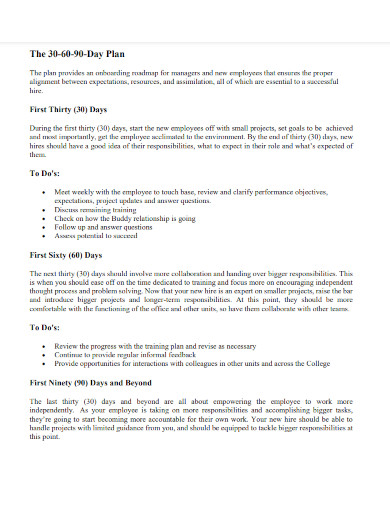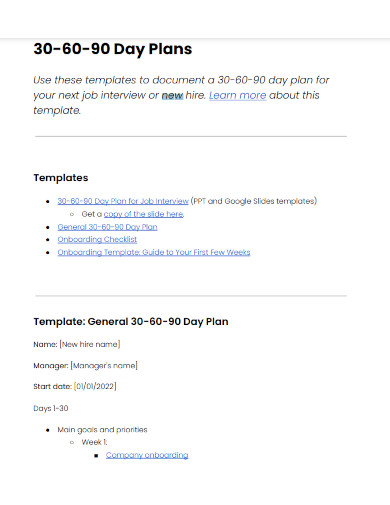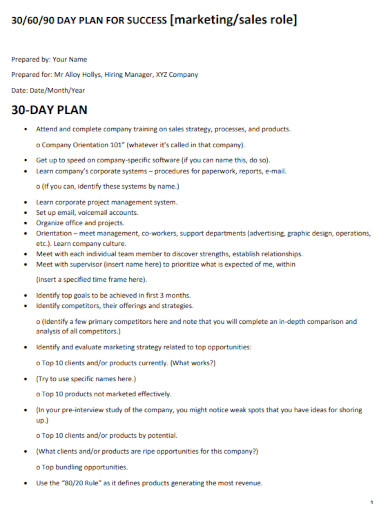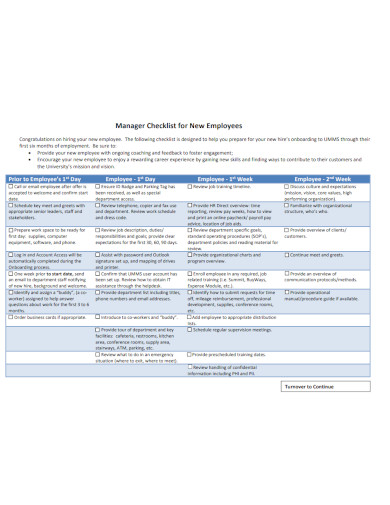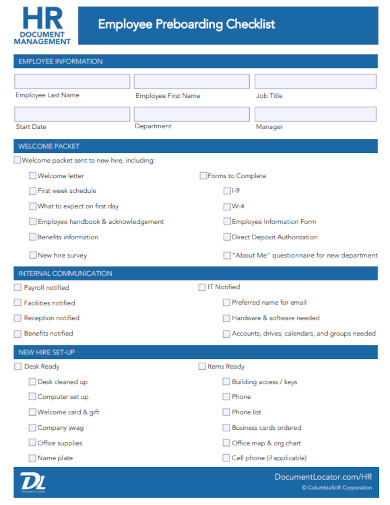Candidates for jobs looking for a competitive advantage in an job interview and new employees looking for some direction when they begin a new career are typically advised to develop a 30-60-90 day plan. This is the initiative you look for when hiring someone, but if your new employee still needs a 30-day, 60-day, or 90-day plan, you should encourage them to establish one for themselves. A decent plan for the first 30, 60, and 90 days on the job can serve as a strategy roadmap to guide someone through their new workplace, and the structure it offers can help new employees get off to a strong start. These strategies may become an essential component of your company business.
5+ 30-60-90 Day Plan for New Employees Samples
1. 30-60-90 Day Plan for New Employees Template
2. Job Interview 30-60-90 Day Plan for New Employees
3. New Employee 30-60-90 Day Onboarding Checklist
4. New Employees 30-60-90 Day Plan for Success
5. 30-60-90 Day Plan for New Employees Checklist
6. 30-60-90 Day Plan for Employee Preboarding Checklist
What is 30-60-90 Day Plan for New Employee?
A new employee’s first three months on your team should be mapped out according to a 30-60-90 day schedule. It outlines in minute detail all your new employee should have accomplished by the time they reach the end of their third month on the job, beginning with their first week. The team members should have a precise plan for coming up to speed and achieving their learning professional goals, which is the purpose of a plan that spans 30-60-90 days. It ensures that every new employee feels welcome in the firm and is aware of the obligations associated with their position.
Even while a 30-day, 60-day, and 90-day plan is frequently suggested to workers moving into managing or business executive roles, these plans can be useful for employees at virtually any level. Together, you and your employee may set expectations and get ready for success with the support of a plan that covers the next 30-60-90 days and is guided by you.
How To Make a 30-60-90 Day Plan for New Employee?
In most cases, you will draft a strategy for the next 30-60-90 days either before bringing on your new employee or right after they start their new work. Because of this, you likely don’t know a lot about your new employee’s personality or strong points. Instead of tailoring your 30-60-90-day plan to the specific capabilities of each team member, you should instead base the customization of each plan on your expectations for what you want that individual to become in their new role.
Step 1- Ask Questions
After you’ve brought on a new employee, the first step in developing a plan for the next 30-60-90 days should be to examine the bigger picture and determine where the new employee falls. Regarding the job role, the onboarding procedure, and the team, make sure you ask yourself any questions that come to mind. Questions like “What need do you hope this person would fill?” are great places to start when thinking of ideas. Which particular challenge are you hoping this person will be able to help you solve? What is it that this individual must be aware of to be successful?
Step 2- Set Realistic Expectations
A day-by-day rundown of the tasks that your new employee will be responsible for is not included in your 30-60-90 day plan. Instead, your objective should be to provide the newly hired employee with an outline of their role inside the organization. When developing your 30-day-to-sixty-day-to-ninety-day strategy, you should also keep in mind that a newly hired team member can only accomplish and learn so much in the first few months of their employment. Try to put only a little on your new employee’s plate quickly, even though you may have some pressing issues that need to be addressed.
Step 3- Create SMART Goals
A study that Bamboo HR conducted in 2014 found that within the first three months of employment, the typical business loses one-sixth of its newly hired employees per month. It is possible to increase employee retention by establishing precise goals throughout the onboarding process. This is especially true if the goals are SMART, which stands for specified, measurable, achievable, realistic, and time-bound. SMART goals are useful for clarifying expectations and providing team members with distinct next steps to take. In this way, there is less of a chance that newly hired employees may feel overwhelmed or disengaged.
Step 4- Provide a Guide
It is not appropriate to provide a new employee with a copy of the 30-60-90 day plan and then send them off to carry out their responsibilities without first discussing the plan. When your new employee is working with you and the other team members to complete tasks, this paper should be a reference for them. When developing your plan, give the new employee a mentor who can provide them with any assistance or direction they might require. During the first few weeks on the job, this individual will be their primary contact for any questions. Your new employee will feel less overwhelmed by their new work environment if they have access to a helpful mentor who can orient them to their new workplace.
What are the advantages of a plan that spans 30 days, 60 days, and 90 days?
You can improve your onboarding process and set new employees up for success by developing a plan that covers their employment’s first 30, 60, and 90 days.
What should newly hired employees to aim to accomplish in their first three months on the job?
The primary goals of your new employee for the first three months on the job should be to become familiar with their job description and to integrate themselves into the company culture.
How to use a 30-60-90 day plan in your workplace?
30-60-90-day plans can be implemented in several ways. Like most staff development tools, there’s no right or wrong way to use these plans.
When it comes to monitoring the objectives and development of newly hired employees during their first few months on the job, a plan with milestones at 30, 60, and 90 days is an excellent tool. It gives them a sense of direction in offering value to the new organization they are working for.
Related Posts
FREE 9+ 30-Day Marketing Plan Samples in PDF | MS Word | Apple Pages | Google Docs
FREE 3+ Sales Team Action Plan Samples in PDF | MS Word | Apple Pages | Google Docs
Marketing Plan For Small Business Samples
FREE 7+ Fashion Business Plan Samples in PDF
FREE 10+ Sprint Planning Samples In MS Word | Google Docs | PDF
FREE 10+ Wedding Planning Samples in MS Word | Apple Pages | Powerpoint | PDF
FREE 9+ Monthly Study Planner Samples in PSD | Illustrator | InDesign | PDF
FREE 9+ Sample Curriculum Planning Templates in PDF | MS Word
FREE 10+ Teacher Development Plan Samples in MS Word | Google Docs | Apple Pages | PDF
FREE 10+ Basketball Practice Plan Samples in PDF
FREE 12+ School Business Plan Samples in PDF | MS Word | Apple Pages | Google Docs
FREE 7+ Client Strategic Plan Samples in PDF | MS Word
FREE 11+ Trucking Business Plan Templates in PDF | MS Word | Google Docs | Pages
FREE 7+ Small Hotel Business Plan Samples PDF | MS Word | Apple Pages | Google Docs
FREE 14+ Bakery Business Plans in MS Word | PDF | Google Docs | Pages

